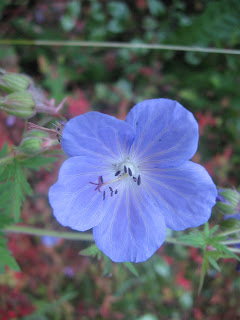I was at first rather alarmed at the rapid spread of Geranium x oxonianum "Claridge Druce' but after it tamed whole beds formerly weed-prone into a nice even bed of greenery studded with light magenta flowers, I started to warm up to its enthusiasm.
Another geranium you don't want to mess with that makes an excellent low ground cover even in dry shade under trees or on a steep bank, is Geranium macrorrhizum. Here she is nearly in bloom-
Another one that is a very restrained seeder and seems to make different strains easily, is Geranium pratense, it is a tall lanky plant and has pale bluish purple 1" flowers; so far it has been solitary, not in clumps-
One that is a delightful self-sower and has a very pretty low mounding growth form is Geranium sanguineum 'Max Frei', for a magenta bloom. These can be studded with flowers in spring.
The 'Striatum' cultivar has a light pink flower with lovely darker pink highlights, note the deeply incised leaves-Another that has begun to pop up self-sown in a very restrained manner is also covered with blooms in spring, and has a gloss or sheen to the delicate leaves, Geranium nodosum, and a light purple flower-
Some other geraniums perform well but I haven't noticed them self-sowing. Geranium 'Ann Folkard' has low-growing foliage that trails several feet away and has a few scattered flowers for most of the bloom season. The flowers have an intense eye-pleasing magenta color hard to photograph, more like the flower on the right, and a sheen to the petals.
One that increases by making clumps and stays very low is Geranium cantabrigiense 'Karmina', and has a long bloom season. It is an excellent ground cover, easy to divide. There is a little Herb Robert growing with it. Other cultivars have different flower colors.
Another photo of a charming mix of G. sanguineums and a dark purple one possibly G. himalayense.
One that I grew several years but did not return finally that was a favorite was G. incanum 'Frances Grate', AKA Silver Sugar Plum, which is an appropriate name, with magenta flowers and incredible finely cut lacey silver foliage.
These geraniums have been hardy in my zone 8 (sometimes down to zone 6 temps) and some are hardy to at least zone 5, check the cultivar for hardiness in your zone.
Happy Summer, Hannah



















































